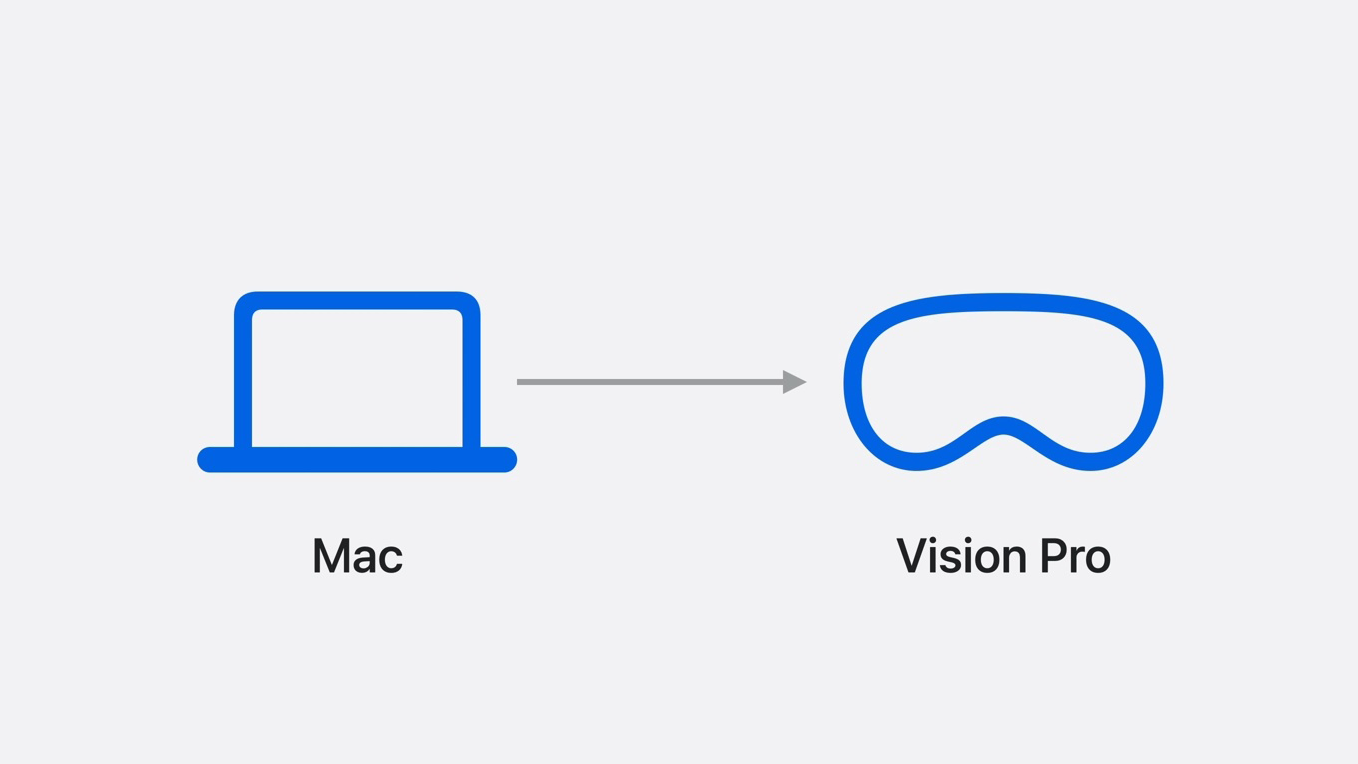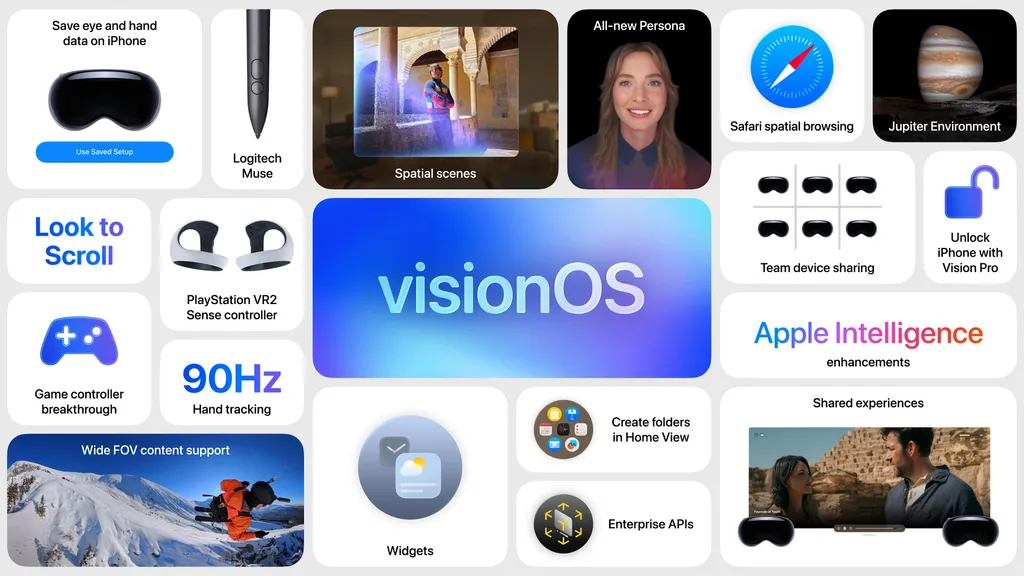Apple just announced visionOS 26 for Apple Vision Pro at WWDC25.
visionOS 26 will bring PlayStation VR2 Sense controllers & Logitech Muse stylus support, much more realistic Personas, spatial Widgets, 90Hz hand tracking, volumetric Spatial Scenes, local SharePlay, and much more.
While you might have expected the next version of Vision Pro's operating system to be visionOS 3, Apple has switched to a unified year-based naming system for all of its operating systems. While visionOS 26 will launch later this year, most of its lifecycle will span through 2026.
visionOS 26 is set to launch later this year, and the first beta is available now for developers.
Here's everything coming in visionOS 26:
PlayStation VR2 Sense Controllers
As rumored for months now, visionOS 26 will add native support for the PlayStation VR2 Sense controllers, which Sony will sell separately from the headset.
Apple says this will bring "a new class of games" to Vision Pro.
PS VR2 Sense controller support will include 6DoF positional tracking, capacitive finger touch detection, and "vibration support". It's unclear whether precision haptics will be supported, nor the unique resistive triggers of the PS VR2 Sense controllers.
Significantly Improved Personas
In visionOS 26, Apple says Personas, the platform's face-tracked realistic avatars, have been "transformed to feel more natural and familiar" thanks to "industry-leading volumetric rendering and machine learning technology".
Apple claims these new more realistic Personas have "striking expressivity and sharpness, offering a full side profile view, and remarkably accurate hair, lashes, and complexion". The company has also expanded the eyewear options for your Persona to include over 1000 variations of glasses.
Apple says the new Personas are still generated in a matter of seconds via holding the headset up to let it scan your face.
Pinning, Persistence & Widgets
With visionOS 26, you'll be able to pin windows and volumes to physical surfaces like your walls, and they will persist between restarts.
visionOS 26 will also bring Widgets to the platform, leveraging this pinning and persistence capability. You position these widgets in your real space, and they reappear every time you put on the headset.
Apple says visionOS Widgets are customizable with options for "frame width, color, and depth". Built-in widgets will include Clock, Weather, Music, and Photos, and developers will be able to build their own using WidgetKit.
The persistence and surface-alignment capabilities can also be used in visionOS apps via new APIs.
Truly 90Hz Hand Tracking
At launch, Apple Vision Pro's hand tracking was limited to 30Hz, and we noted in our review that this made it feel sluggish and unresponsive in games.
With visionOS 2, developers could now opt to be provided with hand tracking at up to 90Hz, significantly improving the responsiveness.

Now, with visionOS 26, Apple says the underlying hand tracking algorithm actually samples the sensors at 90Hz.
Volumetric 'Spatial Scenes'
Since the launch of Apple Vision Pro the headset has been able to capture and display 3D photos, which Apple calls Spatial Photos, and visionOS 2 added the ability to convert any 2D image into a Spatial Photo using machine learning.
visionOS 26 is set to go much further. It introduces Spatial Scenes, which leverages "a new generative AI algorithm and computational depth to create spatial scenes with multiple perspectives, letting users feel like they can lean in and look around".
Spatial Scenes can be viewed in Photos app, which lets you convert any photo into one.
They'll also be available in Apple's Spatial Gallery platform, as well as web pages in Safari, and developers will be able to add them to their visionOS apps using a new Spatial Scene API.
Local SharePlay
Until now, it wasn't possible to build visionOS apps that let multiple Vision Pro headsets automatically see the same objects and interfaces at the same locations in the same physical space, a feature known as colocation on Quest and Pico.
visionOS 26 will bring this capability to Vision Pro, leveraging the existing SharePlay technology and APIs that today let Vision Pro owners share experiences remotely.
Logic Muse Spatial Stylus
visionOS 26 adds support for the upcoming Logitech Muse accessory, a spatial stylus for Apple Vision Pro.
Apple says Logitech Muse "enables precise input and new ways to interact with collaboration apps like Spatial Analogue".
It looks to be very similar to the existing Logitech MX Ink spatial stylus for Meta's Quest headsets.
Spatial Browsing In Safari
visionOS 26 is set to bring major new features to Safari on Vision Pro.
The new Safari will allow web developers to embed 3D models in web pages, and users will be able to drag these 3D models into their space.
A new feature called Spatial Browsing builds on the Reader Mode of Safari to deliver an "immersive" feeling of browsing a webpage, where 2D images become Spatial Scenes.
Native 180° & 360° Video Support
visionOS 26 will add native support for traditional 2D 180° and 360° video, not just Apple's own 3D Apple Immersive Video format.
Apple says this allows you to easily watch content captured on affordable 180° and 360° cameras from companies like Insta360, GoPro, and Canon.
Folders In Home View
With visionOS 26, you'll be able to create folders of apps in the home screen, just as you can on iOS and iPadOS.
Currently there is just one folder, which holds compatible iPad and iPhone apps.
Unlock iPhone & Answer Its Calls
With visionOS 26 and iOS 26, you'll be able to unlock your iPhone while wearing Vision Pro.
You'll also be able to answer calls being made to your iPhone, which will be redirected to visionOS.
Jupiter Environment
visionOS 26 will add a new Jupiter home environment.
The new environment will place you on Amalthea, one of the gas giant's closest moons, and let you "speed up time to watch enormous storms swirl across the gas giant as sunlight breaks across its surface".
Look To Scroll
A new option in visionOS 26 called Look To Scroll will let Vision Pro owners "explore apps and websites using just their eyes".
We'll be very curious to see exactly how this feature works, as it's not clear from the description.
Game Controller Breakthrough
Apple Vision Pro always segments and shows your real hands and arms, and since visionOS 2 it shows your physical keyboard, a capability called Keyboard Breakthrough.
visionOS 26 will bring Game Controller Breakthrough, doing the same for PlayStation and Xbox gamepads, as well as the PS VR2 Sense controllers.
Apple Intelligence In More Countries
visionOS 2.4 brought Apple Intelligence to Vision Pro, but only for US English.

visionOS 26 will expand this to English in Australia, Canada, India, Singapore, and the UK, as well as French, German, Italian, Japanese, Korean, and Spanish.
Foundation Models Framework
With visionOS 26, developers will also be able to use the Apple Intelligence on-device LLM (large language model) in their own visionOS apps, via the new Foundation Models framework.
This includes guided generation for structured output, and tool calling to let the model take actions.
The Foundation Models framework will enable generative AI in even free apps, in contrast to the current situation where apps need to use paid server-side models.
Team Device Sharing
With visionOS 26, enterprise companies will be able to save eye and hand tracking calibration and accessibility settings to each employee's iPhone, and this configuration can be used on shared Apple Vision Pro headsets.
macOS Spatial Rendering
macOS 26 will let apps render and stream immersive experiences to visionOS 26, essentially Apple's take on PC VR.

"With macOS spatial rendering, use the power of your Mac to render and stream immersive content directly to Vision Pro."






























